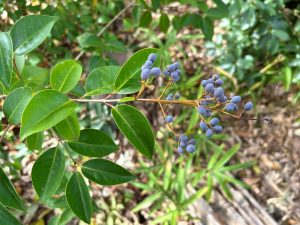◆12/11~12/13 北海道研修全体概容
上田 知弥
(工学部地球工学科3回生)
12月11日~13日の三日間、北海道研修として北海道にある廃棄物処理施設の見学を行いました。今回は浅利研究室の学生、エコ~るど京大のメンバーの他、社会人の方々も多数参加しており、25名ほどで研修を行いました。初日は旭川駅に集合し、当麻町にある田中石灰工業(株)旭川プラスチック再生センターを見学したのち、バスで塩別つるつる温泉へと向かいました。二日目は、日本唯一の水銀リサイクル処理企業である野村興産株式会社のイトムカ工業所を見学したのち旭川へ戻り、旭山動物園にて、環境教育展示の視察を行いました。
近年話題となっているプラスチック問題。そのライフサイクルの出口であるプラスチックのリサイクルセンターでは、廃プラスチック類がどのように分別され再利用するために処理されているのかを学びました。
また、国内で唯一水銀リサイクルを行っている野村興産株式会社のイトムカ工業所では、職員の方から水銀の歴史と現状についてレクチャーを受け、そのあと蛍光灯や水銀を含む体温計、乾電池を処理している施設の見学をさせていただきました。
以上2点につきましては、後ほど個別レポートもありますので、そちらもご覧ください。
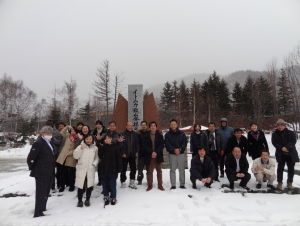
イトムカ工業所にて。
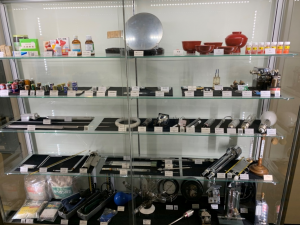
イトムカ工業所にて。水銀使用製品をラインナップしている。
一日目、二日目の夜ともに三月のプラ博に向けたブレインストーミングや、プラチャートに関するアンケートについて議論を行い有意義な時間となりました。そして旭山動物園では、アシカの餌やりの際に海洋ごみ、特にプラスチックごみの話が出るなど、世間的にもそれらに対して関心が高まっていることもうかがえました。
最後になりましたが、この研修でご協力していただいた方々に重ねてお礼申し上げます。
Plastic Waste Management in Hokkaido at Tanaka Sekkai Kogyo Co., Ltd.

Isaac Omondi
(Graduate School of Global Environmental Studies (GSGES) M2)
Our study team visited Tanaka Sekkai Kogyo Co. Ltd in Asahikawa, one of the only two companies in Hokkaido prefecture engaged in plastic recycling. Recyclable plastic is derived from municipal solid waste collected from households in the prefecture. The recyclables are baled and sent for processing at the factory. The company recycles plastic depending on the quality of waste received into plastic pellets or refuse derived fuel (RDF). Pelletized polymers include polyethene (PE), polypropylene (PP) and polystyrene (PS). Generally, when recyclables are received at the factory, they unbaled by breaking the straps. The materials are then sorted, washed, dried and finally pelletized. Some recycling sub processes are manually run by specialized personnel while others fully automated by advanced equipment. Within this process, poor quality plastic is dropped and made into RDF. This service is offered to about 30 municipalities making sure their environment is clean. The study team comprised of Prof. Misuzu Asari and her laboratory, Ecole-de-Kyodai and private companies. Members appreciated this information exchange from the company.

田中石灰工業株式会社、旭川プラスチック再生センターにて集合写真
抄訳
12月11日に、北海道で2か所しかないプラスチックリサイクルを行っている田中石灰工業株式会社を見学しました。ここでリサイクルされるのは道内の家庭ごみから排出されたプラスチックで、それらは梱包された状態で工場に運ばれてきます。工場に着いたのち梱包を解かれたプラスチックは、光学選別機によってPE(ポリエチレン)、PP(ポリプロピレン)、PS(ポリスチレン)に分別されたあと、洗浄、乾燥を経てペレットになります。この過程で質の悪いプラスチックは、RDF(廃棄物固形燃料)へと加工されます。この事業により、道内30の自治体の環境保全に役立っています。
Study trip to the Itomuka Plant of Nomura Kohsan Co., Ltd. In Asahigawa, Hokkaido
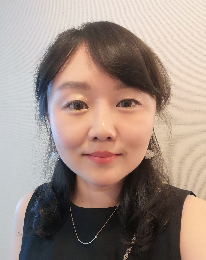
Qing XU (Suzie)
(Guest Research Associate, GSGES)
Mercury is used in a wide range of products and applications, such as fluorescent lamps, batteries, dental amalgam, scientific and medical instruments. All of these finally become wastes. Since mercury cannot be decomposed, it remains in the environment. To protect human health and the environment from the adverse effects of mercury, mercury waste should be managed in an environmentally sound manner pursuant to the Basel and Minamata conventions. But world-while, we still lack the capacity to achieve the goal.
The study team visited Itomuka Plant of Nomura Kohsan Co., Ltd – one and the only company in Japan that has specialized in matters pertaining to mercury waste, on 12th December 2019. The site was a mercury mine owned by Nomura Mining Co., Ltd. which used to be the biggest producer of mercury in the East Japan. Due to the sudden decrease of demand for mercury, Nomura Mining Co., Ltd. was forced to close down. In 1973, Nomura Kohsan took over the technology and site and established the present-day company.
The work of Nomura Kohsan includes the treatment of (1) waste consisting of mercury/mercury compounds, such as metal mercury; (2) waste containing mercury/mercury compounds, such as fluorescent lamps, batteries, measuring devices, etc.; and (3) waste contaminated with mercury/mercury compounds, such as sludge, catalyst, activated carbon.
Domestically, 13,000 tons of used dry-cell batteries, 9,000 tons of used fluorescent lamps and 6,000 tons of other mercury wastes are collected each year from all 47 Prefectures of Japan and treated at Itomuka Plan. Furthermore, the plant also supports the industrial sectors of Japan. For example, they are commissioned by non-ferrous metal refineries to treat the mercury-containing sludge. Here, they remove the mercury from the sludge and send back the mercury-free sludge which contains precious metals such as gold and silver.
Meanwhile, they are also importing and treating mercury waste such as fluorescent lamps, HID lamps, dry-cell batteries, button cell batteries, sludge, catalyst etc. from Asian countries, in accordance with the Basel Convention on the Control of Transboundary Movements of Hazardous Wastes and Their Disposal.
As for the treatment process, at Nomura Kohsan mercury-containing and mercury-contaminated waste are treated through a roasting process. The plant is equipped with two types of furnaces: the Herreshoff furnace (multiple-hearth furnace) and the rotary kiln. The use of each furnace depends on the concentration of mercury. Waste is heated at a temperature of around 600℃ to 800℃ in order to evaporate the mercury. The evaporated mercury would then flow into the exhaust gas channel and would be collected in the scrubber and cooling tower. In order to prevent the remaining mercury from discharging into the atmosphere, a mercury absorber is equipped at the final stage of the process.
Once the hazardous substances have been eliminated through the roasting process, the greater portion of the materials left after the roasting process is recycled. And the small portion of non-hazardous residue that cannot be recycled is stored in the on-site final landfill.
The study team comprised of Prof. Misuzu Asari and her laboratory, Ecole-de-Kyodai and private companies. Participants have visited the Mercury recycling facilities, Mercury stabilization and solidification equipment, and onsite final landfill. They are amazed not only by the advanced mercury waste treatment technology but also the treatment capacity of Nomura Kohsan, which can definitely contribute to the environmentally sound management of mercury in Japan and around the world.

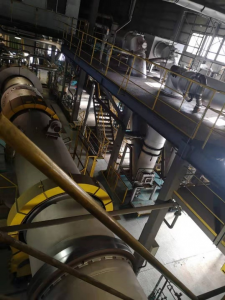
The roasting process facility to treat mercury-containing and mercury-contaminated waste
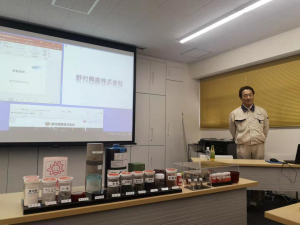
Staff of Nomura Kohsan explaining their business
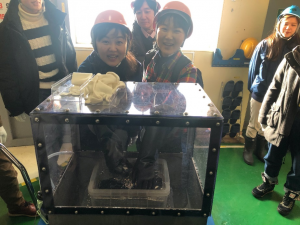
Participants are feeling the Mercury
抄訳
水銀は蛍光灯や電池、医療機器など幅広い製品に使用されています。それらは、すべて使用後廃棄物となるが、水銀が反応性に乏しいため、自然界にそのまま残ってしまいます。人体、そして環境に対する水銀の影響を防ぐため、バーゼル条約および水俣条約に準じて水銀廃棄物を管理するべきですが、その道のりは険しいものがあります。
12月12日に、日本で唯一、水銀廃棄物を取り扱っている野村興産株式会社のイトムカ営業所を見学しました。この地はもともと野村興産株式会社が経営していた水銀鉱山で、閉山後に今の施設を立てて水銀のリサイクルをしています。その仕事は、金属水銀などの水銀そのものの廃棄物、蛍光灯などの水銀含有廃棄物、スラグなどの水銀汚染廃棄物と多岐にわたります。
イトムカ工業所では、日本全国から集まる水銀含有廃棄物を処理しているだけでなく、貴金属を含む汚泥から水銀を除去し水銀フリーとなった汚泥を資源回収に回すことも行っています。水銀含有汚泥の処理過程では、写真にあるようにヘレショフ炉やロータリーキルンといった焼却炉を用いて、600~800℃まで加熱し水銀を蒸発させガスの中から水銀を回収します。この焼却過程で有害物質が取り除かれた残渣はリサイクルに回され、一部のリサイクルできなかったものは敷地内の管理型採取処分場に埋め立てられます。
私たちは、リサイクル施設や水銀安定化装置、管理型最終処分場を見学し、先進的な水銀廃棄物の処理技術だけでなく、野村興産株式会社が日本、そして世界中で環境に優しい水銀管理に貢献していることに驚きました。




